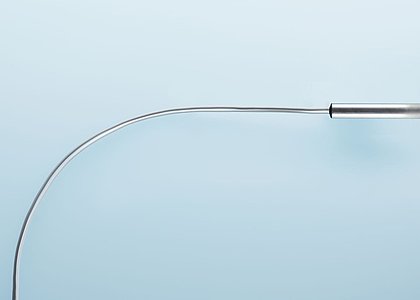At a glance
Product properties
- Mechanically protected in robust metal sleeve
- Moisture-tight version possible (IP66)
- Variable sleeve dimensions
- Preferred construction for IECEx and ATEX approved PTC thermistors
Description
In PTC thermistors with a metal sleeve, the sensor is installed in a metallic protective sleeve made from brass or stainless steel. The thermal conductivity of the metal sleeve guarantees a good thermal coupling to the measuring point. The sensor is connected firmly to the feed using a press squeeze, roll squeeze or casting. Various hose lines or Teflon single wires with various cable cross sections are available as supply lines.
Assembly variants
PTC thermistor with metal sleeve and press squeeze
When hose lines are used instead of PTFE single wires, the sensor is connected with a hexagonal squeeze. Using a viton shrinking tube directly between the squeeze and the feed makes the sensor relatively tight. Where tightness requirements are higher, we recommend the use of roll squeezes.
PTC thermistor with metal sleeve and roll squeeze
Compared to the press squeeze, the advantage of the roll squeeze is that there is a continuous seal of the internal measuring resistor. Double beading on silicone hose lines has proved effective for increased requirements against potential moisture penetration.
PTC thermistor with metal sleeve and casting
In this construction, the PTC thermistor incl. feed is installed in the sleeve head with a casting compound. Different casting compounds are used depending on the type and application. Duroplasts (epoxy resins), elastomers (silicones) or quartz powder are used as standard. Temperature sensors constructed in this way are then cured and aged in special temperature ovens.
PTC thermistor with cable shoe
Cable shoe constructions are very easy to install in any location using a screw – with no need for the sometimes complex mounting processes for common constructions with round housing or sleeves. Clamps or plugs specified by the customer can be installed as options. Insulated or uninsulated cable shoes can be used, depending on the temperature resistance required.
Download certificates
Certificates
ATEX (Deutsch)
pdf 226 KB
ATEX (Englisch)
pdf 215 KB
CCC
pdf 861 KB
IECEx 14.0058 U
pdf 297 KB
INMETRO
pdf 1 MB
EAC
pdf 2 MB
UL CSA
pdf 241 KB
Manuals
Deutsch
pdf 573 KB
Englisch
pdf 624 KB
Russisch
pdf 1 MB
Chinesisch
pdf 601 KB
Brasilianisch
pdf 337 KB
Attestation of conformity
Deutsch
pdf 66 KB
Englisch
pdf 62 KB
Brasilianisch
pdf 65 KB
Französisch
pdf 64 KB






